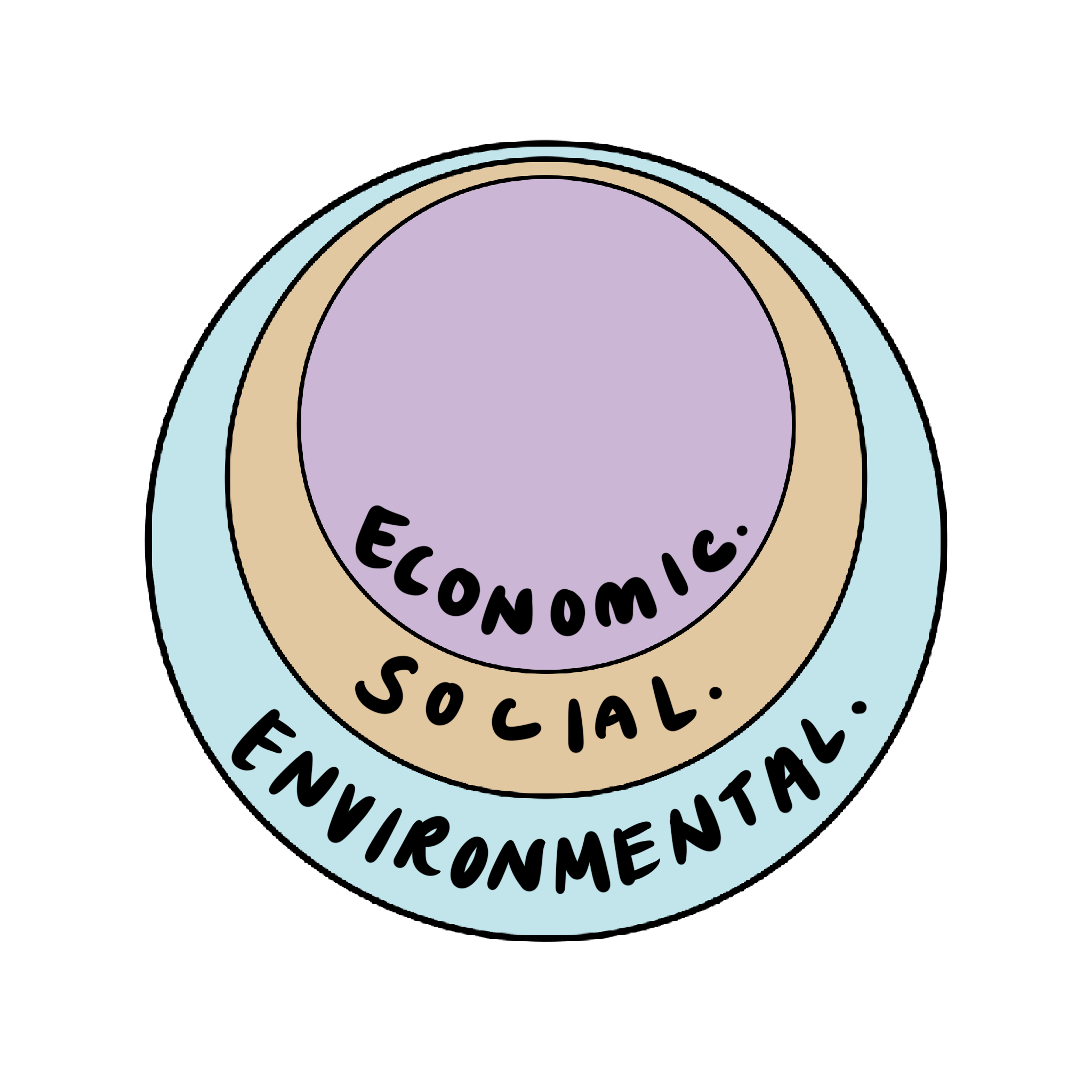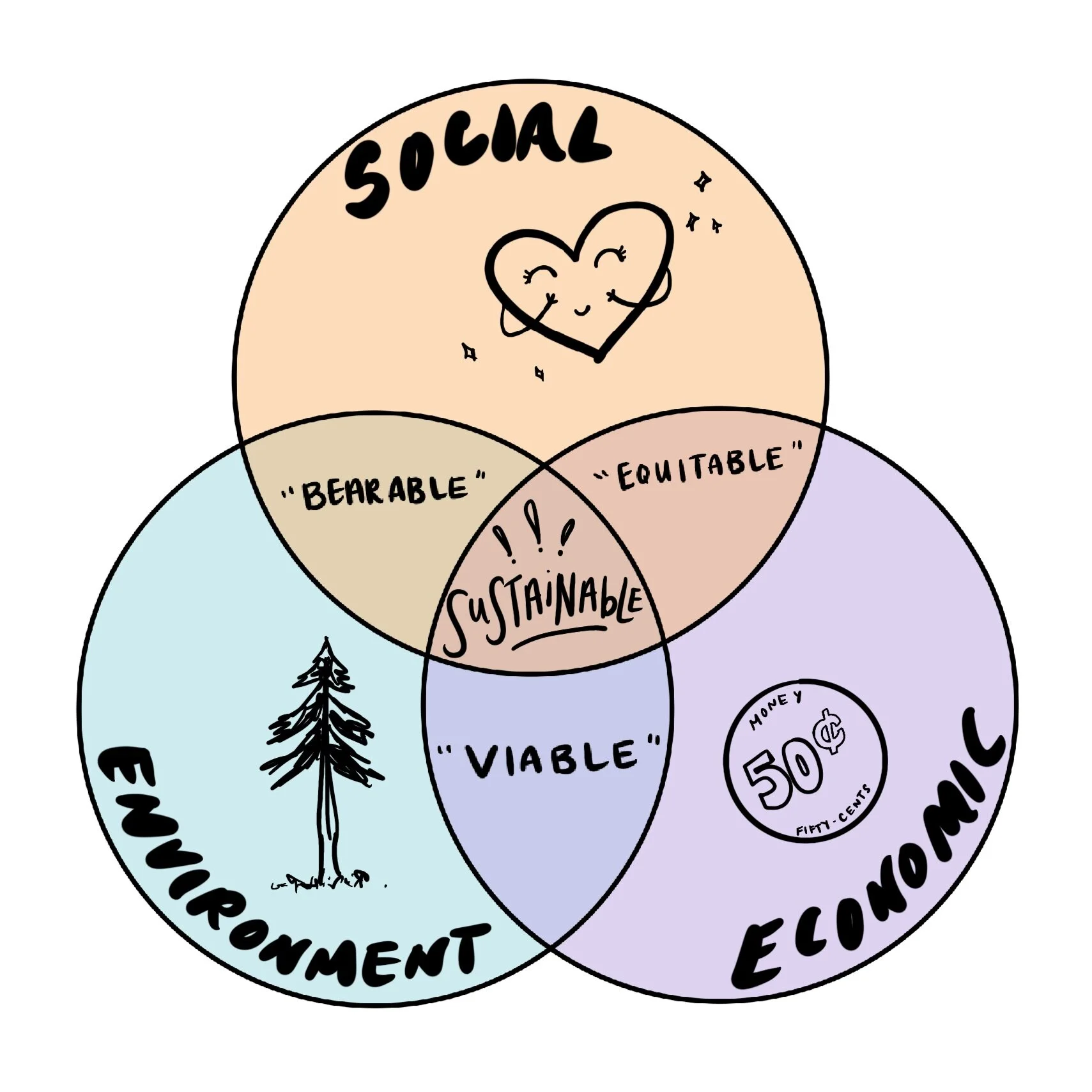Sustainability 101
“Sustainability” is more than a buzzword or trendy marketing term. It’s a mindset, a lifelong practice… and it is essential to the survival of the Universe. This may sound a little dramatic, but allow us to explain… *clears throat + puts on glasses*
Origin Story
In 1713, the original German term Nachhaltigkeit was loosely translated into English as “making only such use of natural renewable resources that people can continue to rely on their yields in the long term”. This term’s original reference was centered around the forestry industry at the time.
Many of Earth’s lively critters inherently understood the potential dangers of overconsuming their resources. Exercising precaution and awareness when consuming resources was second nature to them. Unfortunately, we can all conclude that the world we live in today does not prioritize such awareness.
The attraction to ‘personal prosperity’ over ‘posterity’ (the success of future generations) is the primary reason why the society we participate in today is inherently unsustainable.
In 1987, the “Brundtland Commission” (a sub-committee of the United Nations that aimed to unite countries in the pursuit of global sustainable development) released its final report, Our Common Future. In this report, they redefined sustainability as “development that meets the needs of the present without compromising the ability of future generations to meet their own needs”
The 3 Pillars of Sustainability
Sustainability today models a more holistic approach. It considers all three aspects of a healthy society (economic, social, and environmental factors), and seeks to find the balance that exists within and between each principality.
In the above infographic, we see what are known as the 3 Pillars of Sustainability - Environmental, Social, and Economic Sustainability - and how they are constrained by, and dependent upon one another.
*All Images Subject to Copyright
In the above Venn Diagram, we see how the 3 Pillars of Sustainability overlapping with one another. With this diagram, we are able to visualize how an imbalance between the pillars may manifest itself.
*All Images Subject to Copyright
Environmental Sustainability
Environmental Sustainability is what comes to mind for most people when they think about sustainability in general.
Producing and consuming natural resources in a manner that does not deplete or permanently damage that resource is, in fact, the original idea behind the term. But now it has expanded to include a full spectrum of environmental factors. This pillar directly addresses how we dispose of the products we create from thoughtfully harvested resources.
Reaching full sustainability in this area would require an infrastructure that supports a closed-loop system, including more robust recycling + composting efforts as well as stronger policies enforcing low/zero-waste regulations on large corporations.
Economic Sustainability
Next up is Economic Sustainability, this pillar is greatly influenced by the Environmental pillar of Sustainability.
Economic Sustainability depends upon human communities maintaining sovereignty over their local financial and environmental resources. This looks like equal and unhindered community access to local natural resources, community activities + amenities, and opportunities for safe + secure sources of income.
If natural resources are being mismanaged on an environmental level, then an imbalance on the economic level is sure to follow.
A great example of this is when foreign interests seek and mine for precious materials across the continent of Africa. They destroy the local environments, endanger + exploit the local people for cheap labor, extract the local precious materials, and sell them off on a global market for an insane profit.
These actions undercut the income opportunities of the local population and hinder local economic growth + independence, thus making economic sustainability unachievable.
Social Sustainability
Finally, we have Social Sustainability. This third pillar of Sustainability depends heavily on the Economic pillar’s success.
A fully sustainable society can look a lot like a Utopian society. Universal human rights are honored, basic life necessities are met with ease, and labor + cultural rights are community priorities.
Picture this… an economically stable community that is mentally, physically, emotionally, and spiritually healthy. The people of this community have unhindered access to services that facilitate mental, physical, emotional, and spiritual health. The elected organizing leaders of this community are just, and ensure all members (regardless of financial status) are protected from systemic discrimination.
This is what we imagine it would look like for a society to be fully Economically, Socially, and Environmentally Sustainable.
Sounds amazing, right!?
In Conclusion…
When we look back at all of the things we just wrote, we can’t help but long for a reality where perfect sustainability is actually tangible. Sadly, the world we live in today feels so far from that vision, sometimes it’s hard to believe that we could all come together to make this work.
And even though this all seems so overwhelming and insurmountable, we do not give a DAMN!
This Planet is our home, our future! We refuse to let others trash it using our silence as permission, and our hard-earned dollars as fuel. We have to find a solution!
It is up to us to take accountability for financially supporting brands that do not support their local communities.
It is our duty to demand that they make genuine efforts towards correcting current and past mistakes.
It is our place to take a stand and demand that these companies present ways to be a part of the solution.
There is no more time for us to ignore the problem. We must act now.
Stay tuned for Part 2: The Sustainability Manifesto - Now that we’re all familiar with “Sustainability”, what we gonna do?
Resources
https://youmatter.world/en/coronavirus-ideas-sustainable-actions-couch/
https://youmatter.world/en/definition/definitions-sustainability-definition-examples-principles/
https://youmatter.world/en/tips-start-vegetable-garden/
https://youmatter.world/en/definition/csr-definition/




